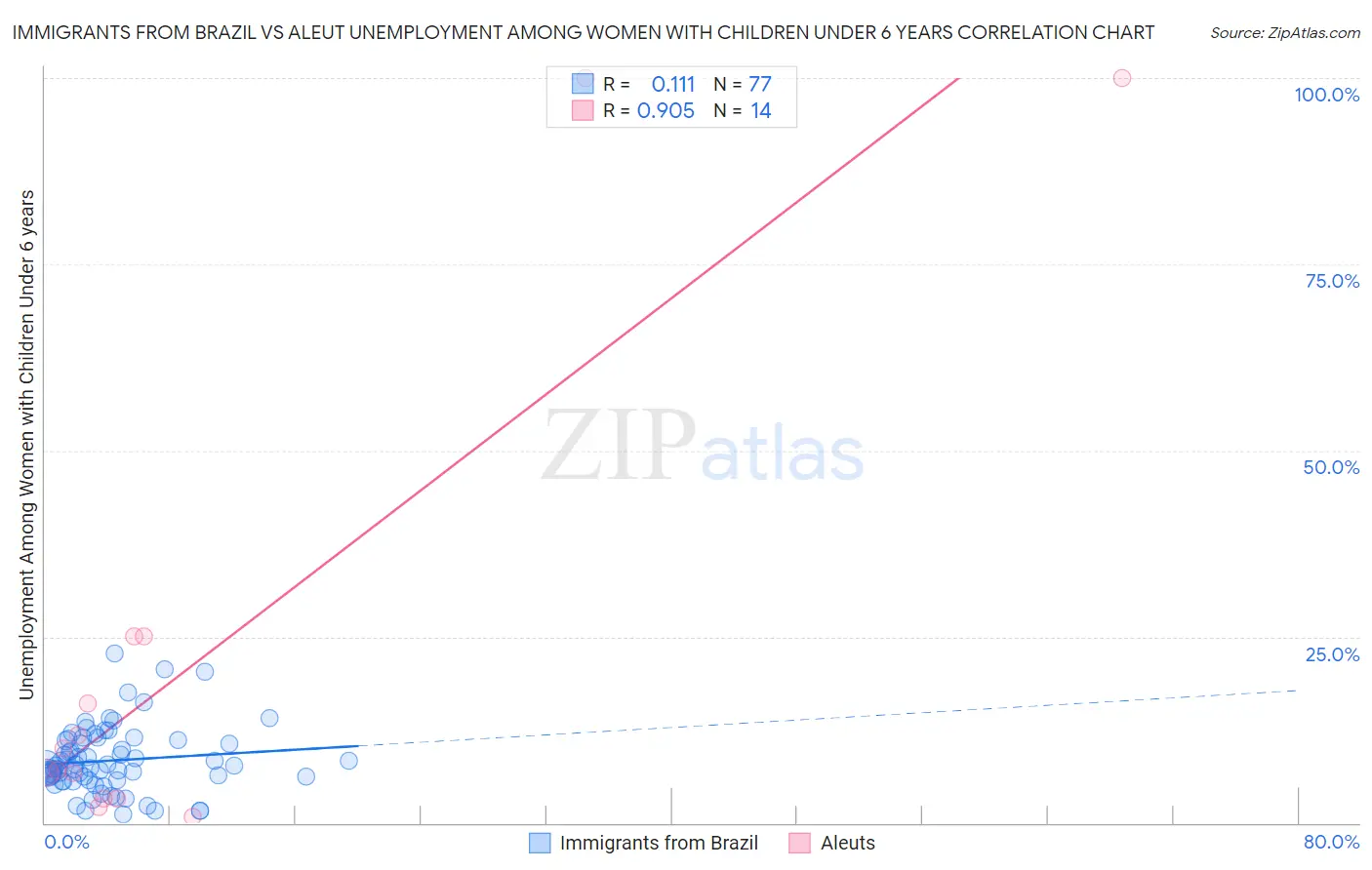Immigrants from Brazil vs Aleut Unemployment Among Women with Children Under 6 years
COMPARE
Immigrants from Brazil
Aleut
Unemployment Among Women with Children Under 6 years
Unemployment Among Women with Children Under 6 years Comparison
Immigrants from Brazil
Aleuts
7.5%
UNEMPLOYMENT AMONG WOMEN WITH CHILDREN UNDER 6 YEARS
77.3/ 100
METRIC RATING
148th/ 347
METRIC RANK
7.5%
UNEMPLOYMENT AMONG WOMEN WITH CHILDREN UNDER 6 YEARS
76.0/ 100
METRIC RATING
150th/ 347
METRIC RANK
Immigrants from Brazil vs Aleut Unemployment Among Women with Children Under 6 years Correlation Chart
The statistical analysis conducted on geographies consisting of 268,259,318 people shows a poor positive correlation between the proportion of Immigrants from Brazil and unemployment rate among women with children under the age of 6 in the United States with a correlation coefficient (R) of 0.111 and weighted average of 7.5%. Similarly, the statistical analysis conducted on geographies consisting of 56,364,668 people shows a near-perfect positive correlation between the proportion of Aleuts and unemployment rate among women with children under the age of 6 in the United States with a correlation coefficient (R) of 0.905 and weighted average of 7.5%, a difference of 0.12%.

Unemployment Among Women with Children Under 6 years Correlation Summary
| Measurement | Immigrants from Brazil | Aleut |
| Minimum | 1.2% | 0.80% |
| Maximum | 22.7% | 100.0% |
| Range | 21.5% | 99.2% |
| Mean | 8.4% | 22.7% |
| Median | 7.4% | 8.5% |
| Interquartile 25% (IQ1) | 5.7% | 3.3% |
| Interquartile 75% (IQ3) | 11.1% | 25.0% |
| Interquartile Range (IQR) | 5.3% | 21.7% |
| Standard Deviation (Sample) | 4.4% | 33.6% |
| Standard Deviation (Population) | 4.4% | 32.4% |
Demographics Similar to Immigrants from Brazil and Aleuts by Unemployment Among Women with Children Under 6 years
In terms of unemployment among women with children under 6 years, the demographic groups most similar to Immigrants from Brazil are Immigrants from Oceania (7.5%, a difference of 0.11%), Colombian (7.5%, a difference of 0.12%), Immigrants from Jordan (7.5%, a difference of 0.16%), Japanese (7.5%, a difference of 0.16%), and European (7.5%, a difference of 0.18%). Similarly, the demographic groups most similar to Aleuts are Colombian (7.5%, a difference of 0.010%), Immigrants from Peru (7.5%, a difference of 0.10%), Bangladeshi (7.5%, a difference of 0.11%), Uruguayan (7.5%, a difference of 0.12%), and Northern European (7.5%, a difference of 0.15%).
| Demographics | Rating | Rank | Unemployment Among Women with Children Under 6 years |
| Immigrants | Colombia | 83.9 /100 | #139 | Excellent 7.4% |
| Scandinavians | 83.0 /100 | #140 | Excellent 7.4% |
| Greeks | 82.6 /100 | #141 | Excellent 7.4% |
| Immigrants | Argentina | 81.5 /100 | #142 | Excellent 7.5% |
| Koreans | 81.3 /100 | #143 | Excellent 7.5% |
| Europeans | 79.1 /100 | #144 | Good 7.5% |
| Immigrants | Jordan | 78.9 /100 | #145 | Good 7.5% |
| Japanese | 78.9 /100 | #146 | Good 7.5% |
| Immigrants | Oceania | 78.4 /100 | #147 | Good 7.5% |
| Immigrants | Brazil | 77.3 /100 | #148 | Good 7.5% |
| Colombians | 76.1 /100 | #149 | Good 7.5% |
| Aleuts | 76.0 /100 | #150 | Good 7.5% |
| Immigrants | Peru | 74.9 /100 | #151 | Good 7.5% |
| Bangladeshis | 74.8 /100 | #152 | Good 7.5% |
| Uruguayans | 74.7 /100 | #153 | Good 7.5% |
| Northern Europeans | 74.3 /100 | #154 | Good 7.5% |
| South Americans | 74.1 /100 | #155 | Good 7.5% |
| Immigrants | Southern Europe | 73.2 /100 | #156 | Good 7.5% |
| Peruvians | 72.3 /100 | #157 | Good 7.5% |
| Croatians | 71.9 /100 | #158 | Good 7.5% |
| Immigrants | Philippines | 71.3 /100 | #159 | Good 7.5% |